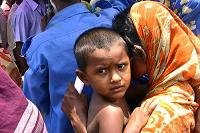
Download The number of women dying whilst giving birth in Bangladesh has been reduced by nearly a half over the last nine years.
About eight thousand five hundred women have stopped dying unnecessarily each year.
David Bergman in Dhaka explores how this success story has happened.
This is a typical slum where most of country’s urban poor live.
This one is called Korail, in the middle of the capital, Dhaka.
I am here to visit a birthing centre run by the country’s largest non-governmental organisation, BRAC.
Dr Rashed is part of a programme called Manushi
“This delivery centre is well known as a delivery centre in the community. It is actually a centre for conducting normal deliveries, It is not a high tech delivery centre but it is sort of similar to their houses to those that we are serving. So it is you can say a replica of their house but it is relatively clean and we have skilled attendants here so we can conduct safer deliveries here.”
The use of skilled birth attendants has been a key factor in reducing the number of maternal deaths in Bangladesh.
“Our personnels who are here staying in our delivery centres they are very much skilled in identifying complications and danger signs and they can take prompt decisions on that. Taking the right decisions at the right time save lives and that is probably that is the reason why maternal mortality has come down in very significantly in Manushi areas.”
However it is not only in areas where the BRAC’s program is running where maternal mortality has come down.
Earlier this year, USAID completed a large nationwide maternal mortality survey.
Kanta Jamil, the program coordinator in the area of population, health and nutrition for USAID, helped coordinate the research.
“What we found was really really impressive, found that maternity declined by 40 percent in Bangladesh in the last nine year.”
The number of deaths reduced from 322 per 100,000 child births in 2001 to 194 deaths per 100,000, in 2010.
“It really created a great stir. We sent the information immediately to Washington, and the news just flew, it was being included in very very high speeches, the Prime minister in Bangladesh actually issued a notice that every one has to publicise this data that this is what had happened and this is the first time I have seen a notice from the prime minister’s office on a research finding.”
The research found that one of the key reasons for the decline was the increasing use of skilled attendants and the willingness of pregnant woman to seek medical care outside there homes if there was a complication.
“Between 2001 and 2010 there has been quite a large increase in woman seeking facility births. Facility delivery has increased from nine percent to 23 percent and that is big change in nine years when for two or three decades nothing had changed. Second one is that even if they are delivering at home, are they aware that if they have complication where to seek care, and are they seeking appropriate care. In 2001, woman who had maternal complications only 16 percent went to a facility to get care and now this has increased to 28 percent.”
However the reduction in mortality is not just about health care interventions.
The reduction in the number of children women are having also plays a role.
“In 2001, women were having on the average three children and now that has declined and on average having two and a half births. What has happened in the last nine years is the high risks births has reduced, the proportion of mothers who were delivering four or more babies, that proportion has come down, and mothers risk of dying is much higher when they are delivering their forth or fifth baby.”
However Bangladesh is still some way from reaching by 2015 the Millennium Development Goal of only 143 maternal deaths per 100,000 births.
Dr Laura Reichenbach who works at the Reproductive Health Unit of the public health research body, ICDDRB in Dhaka says reaching this figure will not be easy.
“When you look at the women who are dying, the major cause of maternal death is post partem hemorrhage and the second is eclampsia. And so those two issues these are still the ones we need to address and I think through very targeted interventions we can hope to continue the decline that we have seen. In order to achieve needs lots of investment in health systems, ensuring that doctors, obstetrician, and anesthesiologist are available throughout Bangladesh so that woman who require Caesarian Section when they go to a facility they can actually get that caesarean section. So I think in some sense we now have really hard work in front of us to get to those women in remote areas and in underserved population as well as the women who are poorest. So ensuring that we develop and design the right programmes is the challenge that remains.”
And back at the BRAC program, the work to reduce the national rate of maternal death continues.
As I leave the birthing centre two heavily pregnant women sit in the delivery room under the watchful eye of a skilled attendant.














